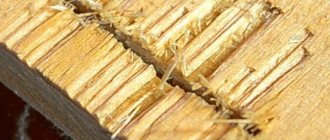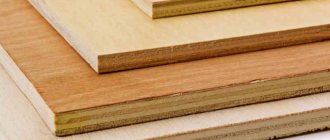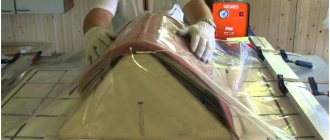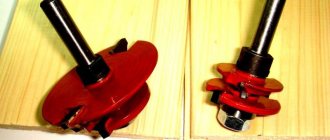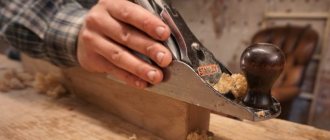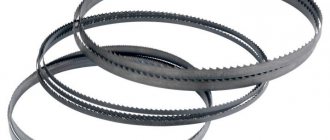Selecting Tools
To cut plywood without chips and cracks at home, use hand and electric tools . In the first case, physical effort is required, so such work is quite tiring. However, it is not always possible to use the electric option. The power tool causes the material to heat up and heats itself up, which is undesirable for large thicknesses. Not every model is suitable for cutting plywood. A good jigsaw or file is not cheap.
Hand tool
Hacksaw for plywood
Whatever tool is used for manual cutting, the work will have the following features .
- Labor intensive - cutting is difficult due to the multidirectional fibers. Cutting a sheet of plywood will require more effort than cutting an OSB board of the same thickness. This is especially noticeable when working with hardwood sheets.
- to secure the slab correctly . The blade is placed on 2 stops to avoid pinching during cutting.
- Using a hand tool, you can cut a workpiece of any shape from the material . This is the main advantage of this method.
The selection of hand tools is very small. To cut plywood, you need a knife with fine, well-sharpened teeth made of hard metal and with minimal setting. The teeth should not have a clear direction, otherwise the hacksaw will not overcome multidirectional fibers.
Wood saw
The choice comes down to 2 options.
- A special saw for plywood – equipped with frequent and small teeth. They provide the most even cut, but do not speed up the work.
- Standard wood hacksaw with fine teeth . It is recommended to take a model designed to work with plastic and laminate. A hacksaw can be used to cut large sheets into fragments of any size.
A hand jigsaw is most suitable for cutting out parts of complex shapes . Small teeth allow you to work with multilayer material, and the thinness of the blade and the design of the tool allow you to cut out parts in any area, including the central one.
When working, you need to monitor the sharpness of the teeth. After some time, it is recommended to grind with a fine abrasive.
Power tools
Jigsaw
An electric tool allows you to cut slabs much faster. But when choosing here, you need to take into account the features of plywood .
- Models specifically designed for cutting plywood are preferable ; in any case, they provide better results.
- The teeth may have different directions - this is allowed. Depending on the placement of the cutting blade, one side of the slab turns out perfectly smooth, but chips may appear on the second.
- It is allowed to use a hacksaw for metal . But in this case, the work takes a lot of time, since teeth that are too small quickly become clogged with chips and the tool has to be cleaned frequently.
Using a power tool, you can also make curved cuts. However, when cutting thick sheets this becomes difficult.
List of available power tools:
- Jigsaw – to cut plywood you need a model with a power switch so that you can work with material of different densities. A jigsaw with an adjustable stop pad is preferable. In this case, it is easier to make a precise cut. If the device does not have such a function, choose models with a completely flat platform.
- Electric saw for plywood - reciprocating or circular. The first one replaces a jigsaw in cases where you need to work with a small amount of material. Disc is used for cutting large batches. A circular saw requires small attachments with carbide teeth. Its big advantage is the ability to adjust the depth of immersion. This allows you to minimize the number of chips. Disadvantage: a circular saw can only make straight cuts.
- Circular saw – a rotating blade is mounted on a table. In this case, it is not the tool that is moved, but the sheet is fed onto the cutting disk, which is more convenient. For plywood, you need special discs with fine teeth - at least 160 pcs. by 5 cm. When working, you must use a stop.
- Grinder – used for cutting, as it allows you to make an even cut in any direction. However, holding the grinder in your hands all the time is not very convenient. Therefore, it is used for a small amount of work. To cut plywood, a circular saw blade is placed on it.
Valera
The voice of the construction guru
Ask a Question
When choosing a tool, pay attention to the layout of the teeth. The smaller the discrepancy, the more suitable the model is for cutting thin material. The larger the wiring, the more convenient it is to use the saw for cutting thick sheets.
What to choose depending on your goal
The tool is selected depending on the volume and complexity of the work, the thickness of the plywood.
The tool is selected depending on the following parameters.
- Amount of work - if you need to cut sheets for covering 4 rooms, it is impossible to do it manually. Use a circular saw or electric circular saw.
- For straight cutting, any option is suitable. It is more difficult to make a figured cut. Electric tools are too fast and require close attention to cut complex paths.
- The thinner the material, the smaller the teeth the file should have and the smaller the setting. When cutting thick sheets, the teeth clog too quickly, so a model with a slightly wider set is preferable.
- Cuts in a thick slab or in a laminated slab are made with a power tool. It is better to use a special file. You can use a metal file, but this option will have to be cleaned frequently.
A perfectly even cut of the most complex configuration is obtained by laser cutting. A machine with cutters also provides excellent results. However, such equipment is much more expensive.
Content
- Types of tools
- Hand saw
- Circular Saw
- Electric jigsaw
- Features of cutting with each tool
- How to use hand tools
- How to work with a circular saw
- How to cut with a jigsaw
- How to achieve an even cut
- Tips for cutting
Questions about how to cut plywood arise quite often. As a rule, they sell sheets of plywood in standard sizes, but when small pieces are required, you need to pick up a special tool. There are several ways to cut material, each of which has its own characteristics.
How to cut plywood yourself
To get an even, clean cut, you must carefully follow the instructions and follow the cutting technology.
How to make the perfect cut
You can get a smooth edge using either a hand or electric tool.
When working with a jigsaw or saw, a gap appears between the saw sole and the pressure pad. The smaller it is, the less likely it is that the top layer of plywood will break off and chip. Reduce the gap by attaching an overlay plate to the sole. The overlay has slots along which the plywood is cut.
The pad is changed every 5 meters of cut. If you take a plate made of metal or fiberglass, replacement is performed less frequently.
The back side of the plywood is protected with adhesive tape. The material is glued along the length of the cut and the cut is made. Regular tape is not suitable for this. You need tapes with aluminum or fiberglass reinforcement. The width of the tape should exceed the width of the cut by 2 cm. After cutting, it is disconnected, very carefully, so that the separation of small fragments, which are inevitable when cutting, does not lead to chipping and chipping.
How to cut plywood without chipping
To prevent the disc from oscillating, use a stop bar.
To avoid defects during cutting, follow the following recommendations.
- When working with a hand-held circular saw, the minimum number of teeth is set . The cutting part protrudes no more than 5 mm.
- Instead of sizing with tape, the plywood is wetted before cutting . This also reduces the number of fragments.
- When working with an electric saw, the cutting part is brought to the material already turned on . If you run the disk directly into the sheet, the teeth tear the fibers.
- You need to move the saw evenly with the same force. If you press too hard, creases and burns will form. If you move too slowly, the cut will be uneven.
Be sure to use a thrust rack to avoid vibrations of the disk.
What devices to use for straight cuts?
Long straight cuts can be made along the marking line or using guides. For example, a block or corner is attached to the material with self-tapping screws or clamps. The jigsaw is moved by pressing it with the side of the platform against the guide. With this method, markings are made taking into account the position of the file (where the cut will actually be) and the parallel stop.
You can saw using the parallel fence included in the kit. It is inserted into the front of the platform. The support bar is aligned on the flat side of the workpiece. It is not always used, only when the side of the workpiece is flat and the width is suitable, because the stop may not reach the edge of the workpiece.
Sometimes a guide rail is used that holds the jigsaw on both sides rather than on one side.
Cutting along a homemade guide rail
As a result, a jigsaw is a universal tool with a wide range of capabilities. They cannot be overestimated; one must really take into account the power and performance of this tool, especially in the thickness of the workpieces, the length of the cuts, and the strength of the materials. But all the possibilities of a jigsaw as an auxiliary, and sometimes the main tool, are useful to know and use.
Why does a jigsaw cut crookedly?
The saw blade leaving the pre-planned line may be due to several reasons. The operator may not have enough experience in handling the tool, the file may be defective, and the rod and guide roller for the jigsaw may have serious play. In order not to guess from the coffee grounds, it is worth starting to sift out the factors that determine the accuracy and evenness of the cut line in your individual case.
As usual, it’s better to start with yourself and your approach to sawing. Often, novice craftsmen rush things and, wanting to speed up the cutting, apply a lot of pressure to the jigsaw. The tool does not have time to bite evenly into the material and create a clear groove for the file, which begins to follow the path of least resistance and makes unpredictable movements. This problem is especially common when working with thick timber (from 40 mm) and varnished plywood from Soviet times.
This is one of the reasons why the jigsaw moves to the side. What to do about this? The answer is obvious. Apply the minimum pressure sufficient to guide the tool along the line and set the maximum number of revolutions (when working with wood). The pendulum mode usually does not affect the evenness of the cut if its design is in good order.
The quality of assembly and wear of tool parts can be a good reason for the formation of beveled lines when sawing. There are basically no complaints about devices from the budget segment (up to 2,500 rubles), as well as hopes for their conscientious assembly. It’s another matter when original, branded instruments begin to perform such tricks. Often, the cause of a crooked cut is the guide roller, the jigsaw rod or its sole.
You can check the reliability of the element’s fixation by simply tugging it with your hand. Loosening of the rod or roller by more than 1 mm determines that this device is not capable of producing a perfectly even cut. The more play there is in the parts, the less accurate the cutting line they form. This problem should be corrected based on the circumstances. If the part itself is worn out, it can be replaced with a similar one. It is difficult to fix a breakdown if the attachment point to the mechanism is worn out. Not every modern Kulibin undertakes such repairs, and this problem is usually solved by purchasing a new tool.
Unfortunately, the products of many trusted brands are often counterfeited, and jigsaw files are very popular in this regard. It so happens that low-quality and counterfeit products have a rather short service life, which brings many problems to the owner. One of these problems is a crooked cut. An initially smooth blade can bend due to poor-quality metal, which can cause deformation of the tooth set, if it was present at all. In this regard, if your jigsaw cuts crookedly, replacing the saw blade can correct the situation. The process of choosing a high-quality jigsaw file was discussed in detail in a separate topic.
We cut not just correctly, but evenly
In the article below we will look at sawing methods and applications of wood-based panels, and believe me, everything is always interconnected!
Characteristics
Before we start sawing, let's look at the characteristics of the material and, in general, define what plywood is.
Plywood is a board that consists of several layers of special veneer. The strength of the sheet depends on the layers of veneer, and the veneer itself is applied so that the fibers of the new sheet perpendicularly cover the fibers of the previous one.
There are several classes of products and they all differ in appearance, plus they have different prices.
Guide rail for jigsaw
The guide for a jigsaw is a simple device, at first glance, similar to a large metal ruler or rule. The main difference between the tire and the above devices is a special groove along which, like on rails, the sole with a jigsaw mounted on it moves. Most guides have rubberized strips that prevent sliding on the surface of the material, and for additional fixation, they are attached with small clamps. The average length of such devices is from 1.5 to 3 meters, and can be increased by another, similar ruler, using an adapter.
>
